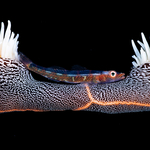From exploring icy Arctic waters to cruising paradise islands few tourists know about, there are still some remote dive destinations to visit. Grab your dive kit, pack your sense of adventure and start planning your trip of a lifetime. Read on to find out more.
Leave the tourists behind at these 9 dive destinations.
1. Siberia Province, Russia.
Step off the beaten path and explore the remote Siberia Province. This snow-dusted area of Russia encompasses most of Northern Asia and hosts the oldest and deepest lake in the world.
Winter diving in Siberia offers fantastic ice and technical diving, but it is not for the faint-hearted. Of all the remote dive destinations, this is one of the more challenging.
Lake Baikal, also called the Pearl of Siberia, has up to 40 meters of water visibility and offers ice diving among eerie green sponge colonies and rocky landscapes. Look closely and you will find endemic crustaceans and numerous freshwater fish.
If you are lucky, you may even encounter the endemic Baikal seal. These adorable seals are the only freshwater pinniped and are often spotted sunbathing along the lake’s shores.
When to go:
Winter for ice diving.
Mid-July onwards for warmer clear waters.
READ MORE: LAKE BAIKAL ICE DIVING ADVENTURES.
2. Tromsø,
If ice diving is not enough of an adventure for you, visit Norway to experience the thrill of freediving with orcas in the middle of the Arctic winter.
These huge cetaceans visit the waters off Tromsø, Norway in great numbers during Norway’s annual herring migration. The waters may be dark due to the low sunlight levels, but there are numerous orcas, huge herring bait balls and humpback whales.
Coming eye to eye with orcas is a life-changing experience. They pass close by and leave a long-lasting impression on everyone who swims with them. After a cold but thrilling day in the water, you can watch the Northern Lights dance overhead from the warmth of your accommodation or liveaboard.
When to go:
October to January.
Visit mid-season for the best chance of numerous orcas.
3. São Tomé and Príncipe.
Sitting in the southern part of the Gulf of Guinea, the small volcanic archipelago of São Tomé and Príncipe is far from any dive destinations you likely know. This small island nation is Africa’s best-kept secret and offers pristine tropical diving.
São Tomé and Príncipe have striking landscapes dotted with waterfalls, biodiverse jungles, and soft white and black sand beaches. Sheer cliffs plunge into the ocean, where you will find dramatic coral and rock formations.
There is still so much to discover at these stunning islands, so dive there before the rest of the world catches on.
When to go:
December to March for peak visibility and warm waters.
4. Myanmar.
Myanmar is an unexplored land of traditional Asian culture and well-preserved landscapes that only opened to tourists in recent years. Whilst some marine areas have been overfished, Myanmar’s remote dive sites offer a wealth of diving opportunities.
The Mergui Archipelago, a cluster of 800 islands in southern Myanmar, has been off-limits since World War II and has diverse underwater landscapes busy with marine life.
With barely any human habitation, Mergui’s horseshoe-shaped beaches are frequented by long-tailed macaques, monitor lizards, and small-clawed otters. Below the water is just as fascinating; with pristine reefs, steep banks, and seamounts rising from the depths.
New dive sites are continually being discovered in Myanmar and mantas, eagle rays, mobula rays, sharks and prized critters are commonly seen.
When to go:
February to May for mantas and whale sharks.
EXPLORE THE 16 BEST CAVE DIVING SPOTS IN THE WORLD.
5. Argentina
Bordered by both the snow-capped Andes mountains and the Atlantic Ocean, and covered in vast rainforests, Argentina’s landscapes are awe-inspiring. With over 4000 km of coastline, it is one of the most varied dive destinations in South America.
You can explore subtropical reefs full of fish in the northeastern region or visit the central region for the highest concentration of dive sites.
Chubut Province is the most popular place to dive in the central region and hosts resident sea lions, southern right whales, thriving marine parks and shipwrecks.
Tierra del Fuego is home to Ushuaia, the departure point for most Antarctica expeditions, and offers diving almost at the end of the earth. There, vast kelp forests host a range of fish species and vibrant nudibranchs, whilst the deep channels are frequented by sea lions.
When to go:
December to March for calmer seas and the best water visibility.
6. Chile
Another of South America’s lesser-known dive destinations, Chile is home to pristine and extreme environments above and below water. It also hosts one of the most sought-after island destinations of all.
You could easily spend your vacation diving solely among the endless dive sites of Chile’s Pacific coastline, but Chile also owns some of the world’s most remote Pacific islands.
The Polynesian Island of Rapa Nui, or Easter Island, is a bucket list dive destination with incredible biodiversity. Being so isolated from humans, the water visibility reaches up to 60 meters there.
You can also go freshwater high-altitude diving along the Andes mountains or dip your toes into the waters around Punta Arenas. As well as having excellent wreck diving, Punta Arenas hosts pods of whales and dolphins, plus cheeky sea lions and numerous penguins.
When to go:
December to March for the warmest waters.
DISCOVER MORE SOUTH AMERICA DIVE DESTINATIONS.
7. Marshall Islands.
The remote Marshall Islands is one of only four atoll nations in the world and offers deep tech-wreck dives plus flourishing reefs full of marine life.
Bikini Atoll in the Marshall Islands was made famous by the US atomic bomb tests in the 1940s and 1950s. These tests included dropping a 15 megaton TNT hydrogen atomic bomb on a US mock naval fleet in Bikini Atoll, creating numerous shipwrecks.
The wrecks are mostly beyond recreational limits, making them ideal for experienced Extended Range divers looking for new wreck dive destinations.
As well as offering excellent wreck diving, these little-known islands host thriving hard coral reefs without any dive crowds. Dive in and you will be mesmerized by the underwater landscapes dotted with pinnacles, drop-offs, and channels.
As the 5th least visited country in the world, you can dive all day and forget the rest of the world even exists.
When to go:
May to October for toasty warm waters.
BECOME AN EXTENDED RANGE WRECK DIVER WITH SSI.
8. New Caledonia & Vanuatu.
Two of the best dive destinations in the South Pacific, New Caledonia and neighboring Vanuatu are hard to choose between, so we recommend visiting them both! Just remember to pack your camera….they are absolutely gorgeous places to dive.
New Caledonia has more than 100 dive sites and is home to the New Caledonia Lagoon, a UNESCO World Heritage Site with an enormous variety of dive opportunities. Imagine deep drop-offs, fast-paced current dives, healthy reefs and more – all protected by extensive marine reserves.
Hop across the water to go diving in Vanuatu and you can swim with dugongs. These charming and gentle animals are found at Gaspard Bay and are a treat to spend time with.
Vanuatu also has pristine reefs and diverse underwater landscapes made up of caves, caverns, overhangs and tunnels. Whether you like easy shallow reefs or exploring the deep, there is plenty to choose from at these idyllic islands.
No trip to Vanuatu would be complete without diving the famous SS President Coolidge wreck, complete with chandeliers and a statue in the interior.
There are also numerous WWI wrecks in Vanuatu’s waters, plus trucks, cranes and bulldozers at Million Dollar Point.
When to go:
New Caledonia: March to September for mantas and sharks.
Vanuatu: All year, though December to April is cyclone season.
READ MORE: 20 OF THE BEST CORAL TRIANGLE DIVE DESTINATIONS.
9. Antarctica
Antarctica, the world’s last untouched wilderness, is as remote as dive destinations get! It is populated by just a handful of researchers and hardy tourists looking for wildlife experiences found nowhere else on Earth.
This is not just a destination for topside tourism though. Those willing to swim in Antarctica’s icy waters will be surrounded by huge ice formations and bright blue waters.
Join an Antarctica dive cruise to explore iconic destinations such as the Falkland Islands, South Shetland Islands, South Georgia and the Antarctic Peninsula. You will have the opportunity to experience ice diving in areas that have never been dived before by other people.
This is a trip for real adventurers, with water temperatures hovering at a chilly 0 °C.
You need to have experience diving in cold conditions but will be rewarded with an un-spoilt region filled with penguins, sea lions and leopard seals.
It is an experience to savor, even more so from the warmth of a cruise ship at the end of each day’s diving.
When to go:
December and January for warmer water, young penguins and seals.
February or March for whale watching.
MEET THE WORLD’S MOST FASCINATING AQUATIC LIFE.
The post 9 Of The Best Remote Dive Destinations appeared first on Dive SSI.
Read MoreTravel, dive destinations, no touristsDive SSI


